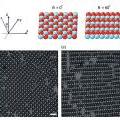Diffusionless martensitic transformations are a class of solid–solid phase transitions in which the crystal unit cell changes shape and internal structure, while keeping its stoichiometry constant. Because these transformations do not require long-range diffusion, they are fast and repeatable, and thus have been exploited in a number of engineeringapplications. Though significantly larger than atoms, colloidal particles are an accessible model for studying these phase transitions in condensed matter, being individually resolvable by optical microscopy, yet sufficiently small to form thermally equilibrated phases at room temperature.
Research Triangle MRSEC investigators, led by Benjamin Yellen, Patrick Charbonneau, and Joshua Socolar, studied fluid–solid and solid–solid transformations in a mixture of magnetic and nonmagnetic colloidal particles immersed in a thin aqueous solution of magnetic nanoparticles and exposed to an external magnetic field. When the applied field is normal to the fluid layer, a checkerboard crystal forms; when the angle between the field and the normal is sufficiently large, a striped crystal assembles, shown in the (a) as cartoons and (b-c) as experimental images. As the field is slowly tilted away from the normal, the transformation pathway between the two phases depends strongly on crystal orientation, field strength, and degree of confinement of the monolayer.
